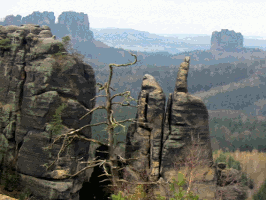Field Trips
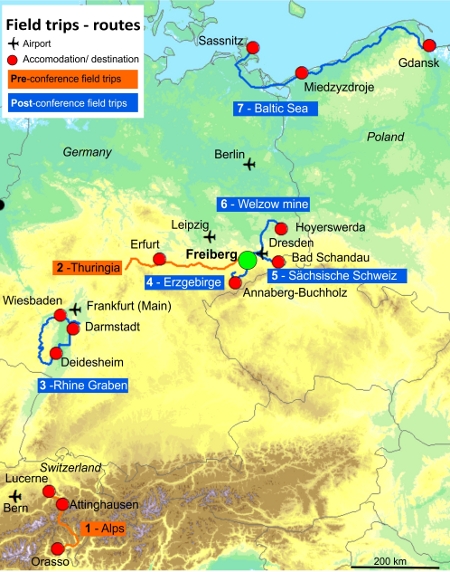 Unfortunately we had only very few registrations to the additional programme. We are thus very sorry that we had to cancel many field trips, by far not reaching the number required participants.
Unfortunately we had only very few registrations to the additional programme. We are thus very sorry that we had to cancel many field trips, by far not reaching the number required participants.
- Pre-conference field trip: From Surface to MOHO - Structure and Evolution of the Central and Southern Alps (September 01 -06, 2015) (Cancled)
- Pre-conference field trip: Permotriassic sediments in the Thuringian Basin (September 05 - 06, 2015) (Canceled)
- Post-conference field trip: Upper Rhine Graben (September 11 - 13, 2015) Cancled
- Post-conference field trip: Geology of the Erzgebirge (September 11, 2015) (Canceled)
- Post-conference field trip: Steep trail hiking in "Sächsische Schweiz" (September 11, 2015)
- Post-conference field trip: Lignite Open Cast Mine Welzow and Power Plant "Schwarze Pumpe" (September 11, 2015)
- Post-conference field trip: Southern Baltic Sea Coast (September 11 - 14, 2015) (Canceled)
- organized by: Jörn H. Kruhl
- Date: September 1 - 6, 2015
- Venue: N-S cross section from Lake Lucerne to Val d’Ossola (Switzerland - Italy)
- Transport: 1 bus
- Min. number of participants: 16
- Max. number of participants: 20
- costs per participant: preliminary cost $590
The amount covers bus transfer (starting from and ending at Lucerne), accommodation and breakfast (4 nights, double rooms); lunch bag, excursion guide. - Preregistration ends by March 31, 2015. You will be informed by April 05, 2015, whether the field trip will take place. Payment has to be completed via the conference website by April 30, 2015.
- Aug 31: Arrival of participants (Lucerne); accommodation: Lucerne
- Sept 1: Lucerne - Lake Lucerne - Altdorf (southern end of Lake Lucerne) (bus travel and easy walking-tours): Geology of the Helvetic Nappes and the Molasse (Rigi, Vitznau, ‘Alte Axen-Straße’ at the east side of Lake Lucerne, Glarus Thrust) Accommodation: Attinghausen
- Sept 2: Altdorf - Wassen - Susten Pass (bus travel and easy walking-tours): Geology of the northern Aar-Gotthard Massif (contact sedimentary nappes - basement rocks at ‘Scheidnössli’, metamorphic and Hercynian magmatic rocks and increasing Alpine deformation and metamorphism of the northern Aar-Gotthard Massif; Stein Glacier at Susten Pass and glacial morphology and structures; optional: visit to the exhibition centre of the Gotthard Base Tunnel) Accommodation: Attinghausen Sept 3: Attinghausen - Gotthard Pass - Bellinzona - Orasso (bus travel and easy walking-tours) Geology of the southern Aar-Gotthard Massif and the Penninic Nappes (from N to S increasing Alpine deformation and metamorphism; variation of structures in Valle Leventina towards the southern margin of the European plate; steep contact zone between European and Adriatic plates (Insubric Line) (Valle Verzasca); accommodation: Orasso
- Sept 4: Upper Valle Cannobina (easy walking-tour): Geology and petrology of the contact between European and Adriatic/African Plates (Sesia Zone, Insubric Line, northern margin of the Ivrea Zone (lower continental crust) and the Finero Ultramafic Intrusive Complex) Accommodation: Orasso
- Sept 5: Orasso - Domodossola - Baveno (bus travel and easy walking-tours): Section across the European-Adriatic/African plate boundary along Val d’Ossola (high-grade metamorphic and magmatic rocks of the southern margin of the European plate, structure of the Insubric Line, cross section through the lower continental crust, late-Hercynian intrusions of the middle continental crust); accommodation: Lucerne
- Sept 6: Return to Freiberg
- organized by: Ines Görz
- Date: September 05 - 06, 2015
- Venue: Thuringia
- Transport: 1 bus
- Min. number of participants: 20
- Max. number of participants: 29
- costs per participant: preliminary cost $290 (single room) or $240 (per person in double room)
- Preregistration ends by May 15, 2015. You will be informed by May 22, 2015, whether the field trip will take place. Payment has to be completed via the conference website by June 5, 2015.
- Gera March Mountain is one of the classical geological outcrops in Germany that exposes the boundary between Rotliegend (lower to middle Permian) and Zechstein (upper Permian). The Rotliegend is a terrestrial succession and comprises red conglomerates deposited in a channel. These rocks were covered by the Zechstein transgression conglomerate, copper shale, fossil rich limestones and typical coast-near sediments like oolithes and dolomites.
- Jena Pennicken Valley. The slopes of the valley are composed of Lower Triassic Bunter sandstones, gypsum and claystones and of Middle Triassic limestones. In a 2-3 hours walk we will also see Karst springs with travertine deposits.
- Gleichen Fortress is located on a prominent group of hills which hosts a medieval ensemble of fortresses. The mountains represent a graben structure that was filled with Upper Triassic clays, marls and sands. The hills formed by topographic inversion due to the erosion resistance of the sandstones with respect to the claystones.
- Erfurt is more than 1000 years old and part of the UNESCO World Heritage. The medieval core of the city contains wonderful street and square ensembles like the Grocers Bridge, which is completely covered with houses, and the old university quarter, which was built between arms of the Gera River. We will stay here over night.
- Dragon Gorge with middle Permian conglomerates, sand- and claystones represents a Permian depression. The rock clasts consist of metamorphic and igneous rocks of the Variscan orogen. Uplift of the rocks during the Cretaceous to Paleogen periods initiated a deep erosion along fracture zones.
- Wartburg Fortress is one of the most important and biggest fortresses in Germany. It contains original houses from the 12th to 15th centuries and was the place where Martin Luther translated the New Testament into German and where the Wartburg festival was held in 1817. The name is probably derived from the German word “Warte” which means lookout.
- Merkers salt mine is a potassium salt mine where Permian salt deposits were exploited. It is now a museum, where experienced miners take visitors on guided tours down to 500 meters beneath the ground surface. On a twenty kilometer underground journey, you will see interesting salt structures and gain insight into potash mining and the working life of the miners.
- organized by: Dr. Rouwen Lehné, Hessian Agency for the Environment and Geology
- Date: September 11-13, 2015
- Venue: Upper Rhine Graben area
- Transport: 1 bus
- Min. number of participants: 15
- Max. number of participants: 45
- cost per participant: preliminary cost $400 including accommodation and breakfast, lunch boxes, entrance fees and wine tasting
- Preregistration ends by May 31, 2015. You will be informed by June 5, 2015, whether the field trip will take place. Payment has to be completed via the conference website by June 25, 2015.
- Stop 1: Ludwigshöhe Darmstadt, Introduction to the region and the geology of the Upper Rhine Graben
- Stop 2: Kühkopf on the river Rhine. The river Rhine as landscape-forming feature.
- Stop 3: Stockstadt. Oil production in the Upper Rhine Graben.
- Stop 4: Visit mineral springs Heppenheim - sediment fill of the Upper Rhine Graben and development of mineral waters.
- Stop 5: Deidesheim. Western master fault of the Upper Rhine Graben. Detection of microtectonic movements.
- Stop 6: Deidesheim. Geological wine tasting.
- Stop 1: Visit geothermal power plant Landau.
- Stop 2: Castle Trifels - overview of the geology of the Palatinate Forest.
- Stop 3: Sea of cliffs Teufelstisch in the southern Palatinate Forest.
- Stop 4: Visit medieval mercury mine Feilbingert.
- Stop 5: Visit Kaiser-Friedrich Spa in Wiesbaden.
- Stop 1: Rochusberg close to Rüdesheim - where the river Rhine enters the Rhenish Shield.
- Stop 2: Visit of the Messel Pit, a world heritage site.
- organized by: Uwe Kroner
- Date: Friday, September 11, 2015
- Venue: Erzgebirge
- Transport: 1 bus
- Min. number of participants: 20
- Max. number of participants: 40
- costs per participant: bus transfer; entrance fee of historical mine; excursion guide; lunch bag: preliminary cost $110
- Preregistration ends by May 15, 2015. You will be informed by May 22, 2015, whether the field trip will take place. Payment has to be completed via the conference website by June 5, 2015.
- organized by: Ines Görz
- Date: September 11, 2015
- Venue: National Park Sächsische Schweiz
- Transport: 1 bus
- Min. number of participants: 10
- Max. number of participants: 20
- costs per participant: preliminary cost $90
- Preregistration ends by May 15, 2015. You will be informed by May 22, 2015, whether the field trip will take place. Payment has to be completed via the conference website by June 5, 2015.
- Enjoy a five hours long hike,
- Be free of acrophobia, since we have to move along vertical walls,
- Wear sturdy shoes with antislip soles,
- Be ready to use your hands for walking.
- Sturdy shoes,
- Clothes with freedom for movement,
- Rain jacket (no umbrella!),
- Drinks,
- Lunch.
- organized by: Helmut Schaeben and Vattenfall Europe Mining AG, Cottbus
- Date: September 11, 2015
- Venue:
- Transport: 1 bus
- Min. number of participants: 20
- Max. number of participants: 50
- costs per participant: preliminary cost $50
- Preregistration ends by May 15, 2015. You will be informed by May 22, 2015, whether the field trip will take place. Payment has to be completed via the conference website by June 5, 2015.
- organized by: Junjie Deng, Catarina Guerreiro, Michal Tomczak, Jan Harff
- Date: September 11 - 14, 2015
- Venue: south Baltic Sea coast
- Transport: bus
- Min. number of participants: 20
- Max. number of participants: 35
- costs per participant: preliminary cost $340, including transportation by bus, accomodation plus breakfast (not included: meals, insurance)
- Preregistration ends by May 30, 2015. You will be informed by June 05, 2015, whether the field trip will take place. Payment has to be completed via the conference website by June 26, 2015.
- Sept., 11: Departure from Freiberg 8:00 am to Sassnitz, Wissower Klinken (National Park: Crateceous cliff), overnight: Prora (youthhostel)
- Sept., 12: cretaceous chalk mine (open pit), moving from Sassnitz to Międzyzdroje, visiting Swinouscie: Swine gate (Holocene barrier islands, lagoon, back delta), overnight: Misdro
- Sept., 13: Międzyzdroje - Trzęsacz - Łeba - Gdańsk (coastal processes, coastal engineering, dune fields, overnight: Gdańsk
- Sept., 14: in the morning: Gdańsk sightseeing, transport to Berlin, approximate arrival at Berlin 8:00pm
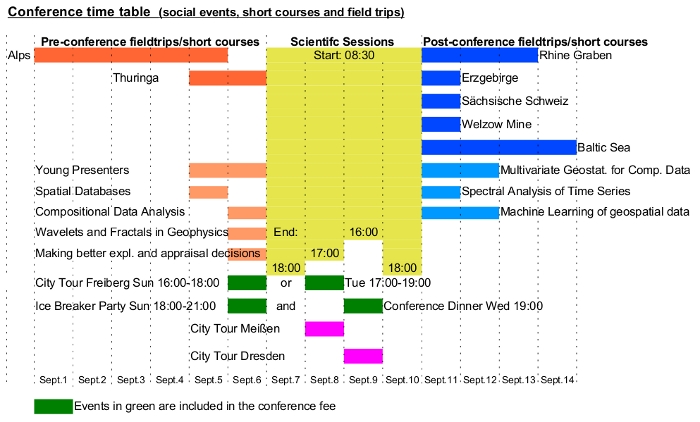
From Surface to MOHO - Structure and Evolution of the Central and Southern Alps↑
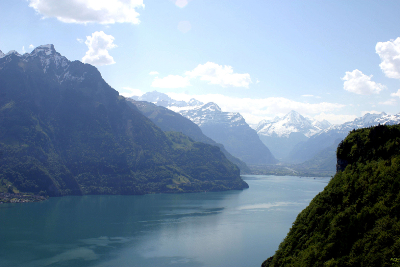
The central and southern Alps between Lucerne and Lago Maggiore represent a unique N-S cross section through the European Alps, which allows the study of the large-scale structure and evolution of a mountain chain that resulted from continental collision. It is the intention of the field trip to examine (i) the beautifully exposed large-scale fold and nappe patterns and the deformation structures of the Helvetic and Penninic Zones and the Aar-Gotthard Massif, (ii) the wide spectrum of exposed sedimentary, metamorphic and magmatic rocks, (iii) the variation of deformation structures with increasing grade of metamorphism from N to S, (iv) the suture between the European and Adriatic/African plates, and (v) petrology and pre-Alpine evolution of the lower continental crust of the Southern Alps.
Pre-conference field trip: Permotriassic sediments in the Thuringian Basin ↑
Venue
The excursion leads to Permotriassic sedimentary successions of Thuringia that form a rolling landscape with woods, fields, fortresses and lovely towns. Wonderful outcrops illustrate the geological evolution of the region. We will move westward starting from Gera and visit outcrops with rocks from nearly all epochs of the Permian and Triassic periods.
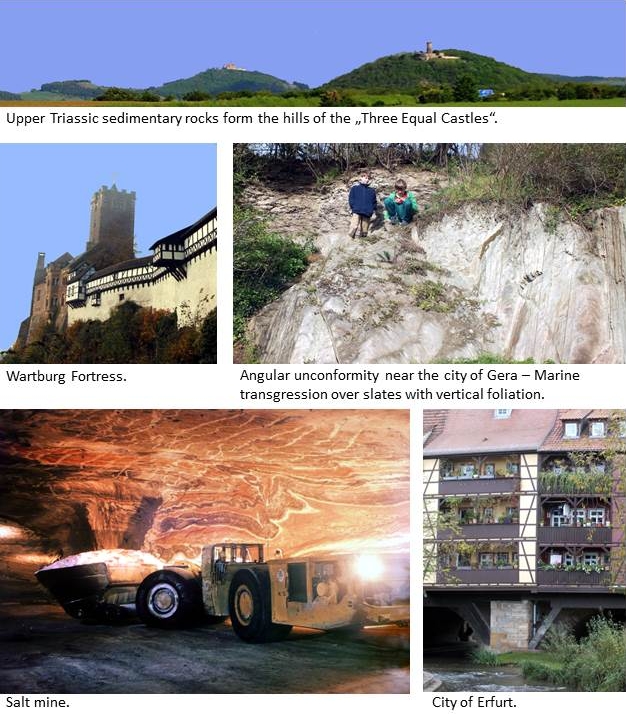
Geology
The geological evolution of the region started with the lower Permian erosion of the Variscan orogen and the deposition of the erosion products in depressions. After the upper Permian Zechstein transgression, carbonates, gypsum, salt and potassium salt were deposited which are important for the economy of Thuringia. The Triassic rocks consist of sandstones, limestones and claystones forming a hilly landscape with steep river valleys, karst springs and travertine deposits. Late Cretaceous to Paleogene tectonic activity resulted in the formation of a syncline structure which is called the Thuringian Basin.
1st Day:
Start at 9 am in Freiberg,
1 hour bus drive to Gera,
Visit of outcrops in Gera, Jena and Gleichen,
Overnight stay in Erfurt,
Visit of outcrops near Eisenach,
Visit of the salt mine in Merkers until 5.30 pm,
Arrival in Freiberg at approx. 9 pm.
Field trip: Upper Rhine Graben - Geology and its impact on our life ↑
Day 1:
Departure in Freiberg at 7 AM - arrival in the Upper Rhine Graben area around
12 AM
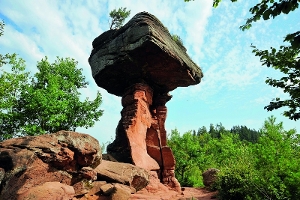
Day 2:
Departure in Deidesheim at 8 AM.
Day 3:
Possible transfer to arrive at Frankfurt Main International Airport at 2 pm.
Geology of the Erzgebirge↑
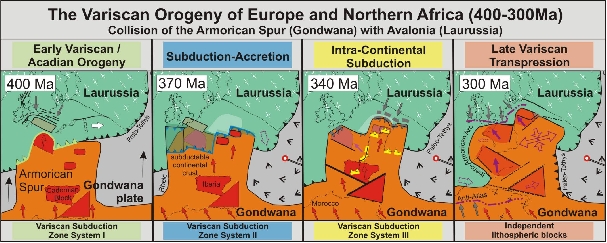
The field trip will focus on subduction and exhumation processes of continental crust (340-330 Ma) during the Variscan orogeny. Advective heat transfer due to the rapid exhumation of deeply buried continental crust into a pre-existing nappe pile is the underlying cause for the late Variscan magmatism and the subsequent formation of the world famous mineral deposits of the Erzgebirge. We will visit outcrops containing the ultra-high-pressure metamorphic rocks, as well as the adjacent medium pressure units thereby discussing the tectono-metamorphic evolution of the Erzgebirge. After visiting an abandoned hydrothermal vent mineral deposit we will discuss the recent efforts of mineral exploration applying large scale 3D models of the region. Since the Erzgebirge is the center of the neptunistic paradigm of Abraham Gottlob Werner (1749 - 1817), we will finally visit Cenozoic volcanics deposited on top of the crystalline basement retracing the historic battle between plutonists and neptunists.
Field trip: Steep trail hiking in Sächsische Schweiz↑
Venue
The national park Sächsische Schweiz is one of the most beautiful and wildest landscapes in Germany. It is situated 80 km to the east of Freiberg. Here, sandstone formations line both sides of the Elbe River and form bizarre rock massifs, needles and deeply carved valleys.
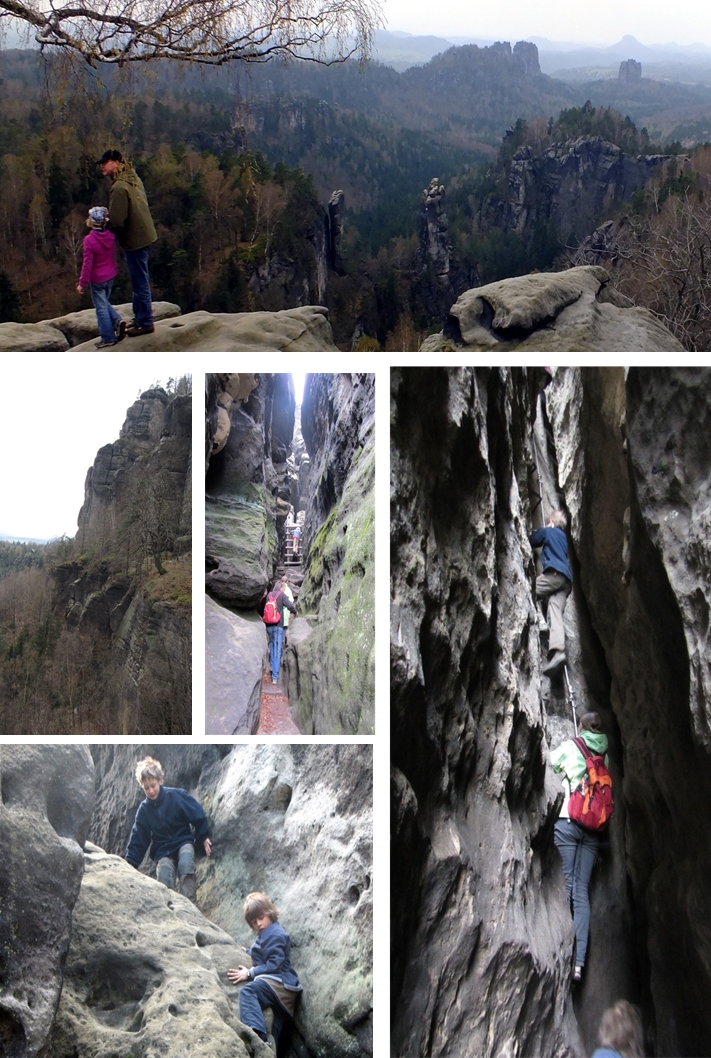
Geology
The region is composed of Cretaceous marine sandstones which formed in a sea strait between the Ore Mountains and the Lusatia Mountains connecting the Bohemian and the North German Cretaceous seas. The compact sandstone units are characterized by a horizontal structure and varying rock strengths. In the late Cretaceous, the Lusatian block was thrust over the sandstones. This produced a dense net of vertical NW-SE and SE-NW striking fissures in them. Since the Neozoic Era, Sächsische Schweiz has been exposed to fluviatile erosion. While the weak sandstone beds are washed away, the hard units break down along the vertical fissures. Thus, the interaction of erosion, rock strength and fracture systems produces a rugged and rocky landscape.
Development of the region
Man has made the region accessible with trails and stairways either to quarries or to military fortresses situated on the rocks. From the 19th century onwards, the region was developed for tourists with ladders, handholds and lookout points with guard rails. It is a spectacular place for hiking on exciting trails and enjoying breathtaking views. Especially children like to climb over the rocks of the steep treks of the Sächsische Schweiz.
Who can participate?
You do NOT need any special knowledge or equipment for climbing. However, if you want to participate, you should:
What do you need?
Where will we go to?
We will go to the
Schedule
Start at 9 am in Freiberg,
90 minutes bus drive to Bad Schandau,
4-5 hours hiking in the
Visit of t> Feste Königstein
90 minutes bus drive to Freiberg,
Arrival in Freiberg at approx. 7 pm.
Field trip: Lignite Open Cast Mine Welzow and Power Plant "Schwarze Pumpe"↑

Key words:
lignite deposit; quality controlled mining; 20 million metric tonnes of lignite per year; power plant "Schwarze Pumpe" capacity 2 x 800 MW, consumption 36,000 metric tonnes of lignite per day;
Schedule(subject to gentle changes)
7.30 am leaving Freiberg by bus
09.30 am - 12.00 am visit of the Open Cast Mine “Welzow Süd”
12.00 am - 12.45 am lunch in the mine’s restaurant
1.15 pm - 3.30 pm visit of the Power Plant “Schware Pumpe“
6.00 pm returning to Freiberg by bus
The lignite deposit of Welzow is located in the south of the federal state of Brandenburg, next to the city of Spremberg. The coal seam has a thickness of about 10 to 16 meters and is covered by about 90 to 130 meters of overburden. The mine produces approximately 20 million metric tonnes of lignite per year. To remove the overburden shovel-wheel and bucket-chain excavators are used. Most of the overburden is transported to the dump site via a belt conveyor bridge. The "Abraumförderbrücken" are the biggest portable machines in the world. With this technology, overburden can be transported from the excavator site to the dump site across the open cast mine in the shortest possible way. Lignite is extracted below the conveyor bridge. Different qualities are mined separately and moved to the central loading facilities via a 2 m wide conveyor belt. The lignite is transported to the power plant "Schwarze Pumpe" by rail. There the lignite is dried and ground. Then the lignite powder is injected into the combustor using a carefully controlled amount of air. In the boiler, water from open cast dewatering is used which was prepared for this purpose at the power plant facilities. The dry and wet ashes are stored in a special deposit. The power plant "Schwarze Pumpe" has a capacity of 2 x 800 MW and consumes 36,000 metric tonnes of lignite per day.
Field trip Southern Baltic Sea Coast↑
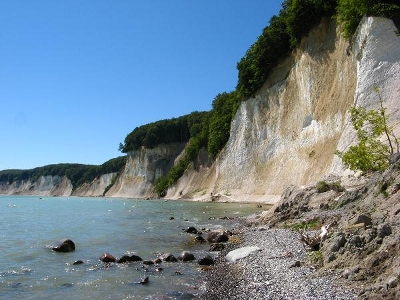
A field trip to the southern Baltic Sea coast in conjunction with the scientific session “Numerical models in marine and coastal geosciences” will introduce the participants to the morphogenetic processes occurring at a coast facing sea level rise and coastal erosion. The state of the art of coastal engineering and management will be explained using selected sites at the German and the Polish coast.

